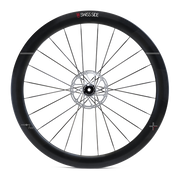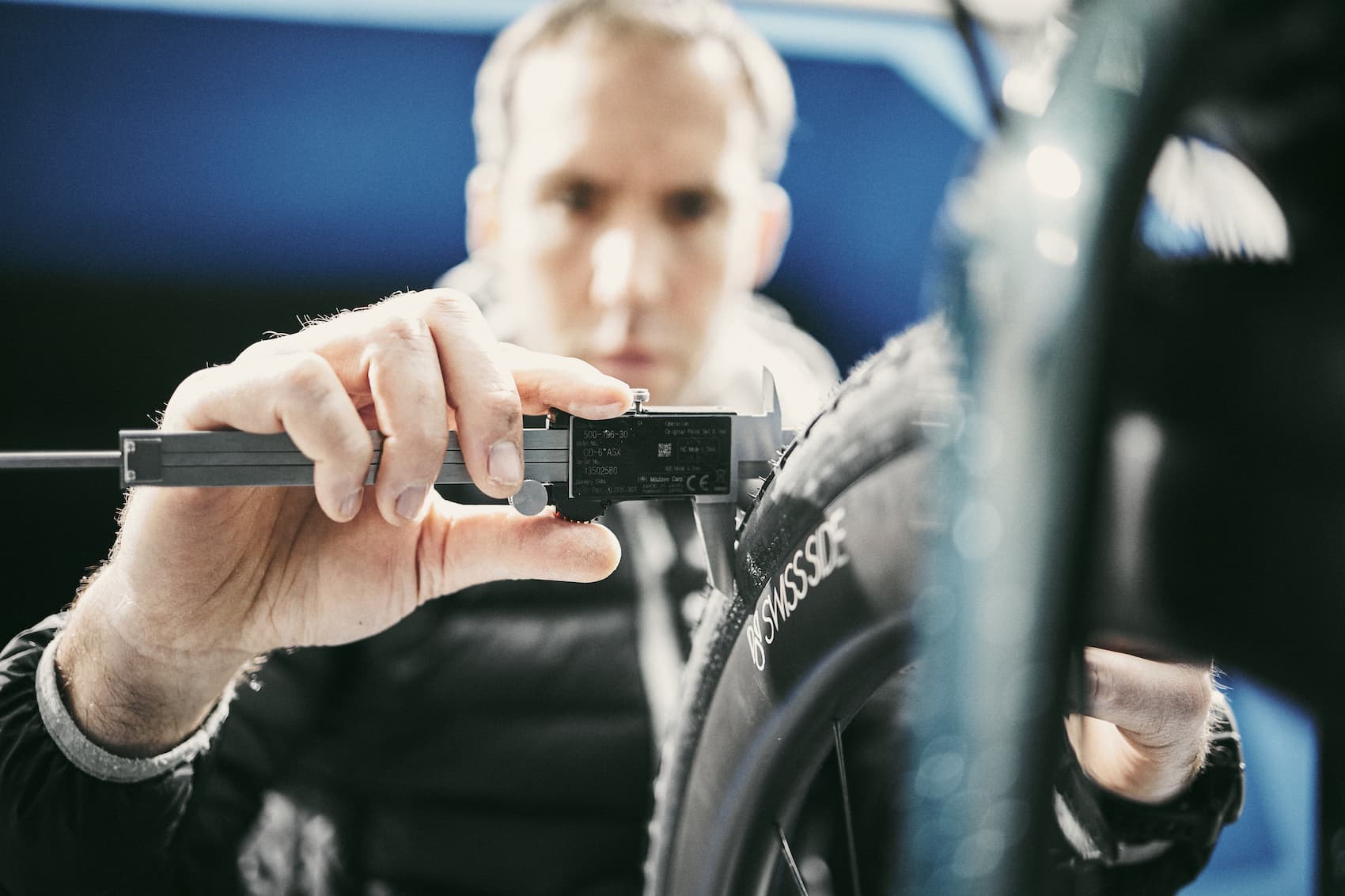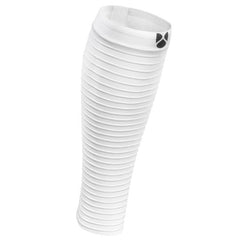With the addition of the new GRAVON 420 and 250 gravel wheel models to the SWISS SIDE line-up, we wanted to show why aerodynamics in gravel riding is also important. The following report transparently details the performance data measured by our engineers, so that you can make your own informed decisions for your gravel wheel and tyre setup.


Topics covered in this report:
- Setting the context. -Overall road bike vs gravel bike performance. What is the base penalty in resistance (aero drag + rolling resistance) for a gravel bike?
- Gravel wheel & tyre setup differences. What is the potential for saving power?
- Gravel tyre width effect on aerodynamic drag.
- Gravel tyre roughness / ‘knob-ness’ effect on aerodynamic drag
- Clean vs dirty gravel bike. What is the aero drag penalty for mud? -Quick and dirty?
Key findings:
- A typical gravel bike setup has around 40W higher overall resistance at 30km/h than road bike, with this penalty split equally between aero drag and rolling resistance.
- Up to 5W aero drag savings with GRAVON 420 aero gravel wheels compared to standard gravel wheels.
- Up to 12W aero drag savings just from the tyre choice.
- Tyre roughness and knob size makes a difference, not only to grip but to aerodynamic drag.
- How much of an aero penalty is a gravel bike caked in mud?... A little bit. -Read on.
- In a race like the ‘Unbound Gravel 200’, the right wheel and tyre choice alone can save over 8.5 minutes. To put this in context, the top 4 riders in 2021 finished within 1.5 minutes!
If you have every ridden your gravel bike out on the road, you may have noticed that you seem to have to work harder to achieve the same speeds. If you have a power meter, you will see a higher power for the same speed. Even though the gravel bike might ‘feel’ smooth and easy to ride, there are two key invisible players working against you. Aerodynamic drag and rolling resistance. To better quantify this, Swiss Side made some measurements both in the wind tunnel and out on the road. Important to note is that the aero drag numbers quoted in this report are limited to the bike only and not the bike + rider system. Actually, the entire system of a gravel bike would have an amplified aero drag penalty due to the more upright and typically higher rider position. So in order to make a clean comparison of the effect of the bike equipment alone, here we publish the bike aero drag only (without rider).

Aero Road Bike Setup:
Cervelo S5 with Swiss Side HADRON2 Utimate 625, Continental GP5000
25mm tyre, 7.0bar pressure.
Gravel Bike Setup:
Cervelo Aspero with Swiss Side GRAVON 250, Continental Terra Speed TR
40mm tyre, 3.0bar pressure.
For making the comparison, two typical high-performance road and gravel bike setups were measured in the wind tunnel at 30, 37.5 & 45 km/h. Rolling resistance data is representative of on-road riding in order to make a direct comparison. (Off-road rolling resistance and 'roll-over resistance' data will be published in an update to this report at a later date. -Stay tuned).
The bike + rider system weight is considered to be 80kg.


There is a significant base resistance penalty for the gravel bike. At 30km/h it is already in the order of 40W and this grows exponentially with increasing speed. Around half the penalty is aero drag and the other half rolling resistance. The aero drag graph shows that the aero drag penalty increases significantly with increasing cross-wind angles. This is because an aero road bike frame profiles are designed to ‘sail’ and harness the wind for reducing drag, whereas the gravel bike frame in this case has no aero profiles and has a significant ‘anti-sailing’ effect with increasing drag with cross-wind. Future gravel bikes will certainly pay more attention to cross-wind aerodynamic performance in the frame design.
So how much potential is there in the aerodynamic drag performance of different gravel wheels and tyres? First of all, the comparison between the GRAVON 420 aero carbon gravel wheel was compared with the GRAVON 250 aluminium gravel wheel model. Then as a second step, a typical ‘Best’ and ‘Worst’ performance gravel wheel + tyre setups were compared in order to quantify the potential in aero drag savings for the different setups:


Gravel Bike Setup: Cervelo Aspero with Swiss Side GRAVON wheels…
GRAVON 420 to 250 comparison: Made with Schwalbe G-One Allround 40mm tyre.
‘Best Performance’ Wheel + Tyre: GRAVON 420 with Schwalbe G-One Speed 35mm tyre.
‘Worst Performance’ Wheel + Tyre: GRAVON 250 with Schwalbe G-One Allround 45mm tyre.

(Tyres used for GRAVON wheel comparison: Schwalbe G-One Allround 40mm)

The GRAVON 420 aero carbon wheel brings an aero drag saving of up to around 5W depending on the speed. This drag reduction will be amplified on windier days due to the enhancing ‘sailing effect’ in cross-wind of the 42mm deep GRAVON 420 rim. It must be considered that with the lower overall speeds of gravel riding, the effective cross-wind (yaw) angle is on average higher, so the performance advantage from improved sailing effects will be amplified in the real world.

Adding the tyre effect to the wheel aero performance differences leads to larger numbers. Between the ‘Best’ narrow 35mm tyre with deep section GRAVON 420, and the ‘Worst’ 45mm wide tyre and the shallow section GRAVON 250, aero drag differences of 5W at 30km/h and up to 20W at 45km/h are measured.
To put this in context, a performance simulation was made based on the top riders of the 2021 ‘Unbound Gravel 200’ event. This is a 206 mile (330km) endurance gravel race with over 3000m of climbing. The top riders complete the race in just over 10 hours with an average speed of 32km/h.
A 5W drag saving (at 30km/h) at this event would save the rider 8.5 minutes in time.
To put this in context, the top 4 riders in 2021 finished within 1.5 minutes of each other. So equipment choices can potentially have a significant impact on result an on energy savings. Also in this respect, the energy saved by the 5W drag saving (@30km/h) is the equivalent of 220kCal which is around 3 energy gels.
Tyre width is an important topic for grip, rolling resistance and comfort. But what is the effect on aerodynamic drag? In order to quantify this, Swiss Side procured some identical model tyres in various widths and tested them in the wind tunnel. The setups tested were as follows:
Gravel Bike Setup: Cervelo Aspero with Swiss Side GRAVON 420 and various tyres.
Tyres: Schwalbe G-One Allround in 35mm, 40mm and 45mm widths.
Continental Terra Speed in 35mm and 40mm widths



The results show that increasing the tyre width increases the aero drag and reduces the sailing effect. The measurement data was very consistent with both the Schwalbe and Continental tyres tested. The differences per 10mm increased tyre width, were around 3.6W at 30km/h, increasing to almost 12W at the higher speed of 45km/h.
The amount of knobs and tread on gravel tyres can be very important for grip off-road, although it is also a big penalty for rolling resistance on-road. So any way you look at it, depending on the terrain of your gravel ride on a particular day, the tyre choice is important. To shed some facts on this topic, the Swiss Side engineers selected 6 typical and well-liked gravel tyres of different levels of roughness or ‘knob-ness’, all with as close to the same (35mm) width as possible. The aero performance was then measured in the wind tunnel in order to quantify if there is a direct correlation between increased knob-size and increased aero drag.
Gravel Bike Setup: Cervelo Aspero with Swiss Side GRAVON 420 and various tyres…
Tyres: See table below.



In general, the rougher the tyre and the size of the knobs, the higher the aero drag and in particular, the sailing effect is reduced. However, the Continental Terra Speed was a slight exception with a low aero drag level and relatively good sailing effect for its comparatively large sized knobs. There is only a 0.4W difference at 30km/h to the more or less slick Schwalbe G-One Speed tyre. So the Continental Terra Speed tyre would appear to be a good choice in terms of compromise between aero performance and grip on loose surfaces.
So can you be quick and dirty? This is the question we wanted to answer. Also, Jean-Paul (Swiss Side CEO) broke the golden rule of not cleaning his bike before bringing it to the wind tunnel so we decided to measure it first, caked in mud, in order to quantify if we can not only see but measure a difference. Note that we kept the wheels and tyres clean in order not to make a proper mess, so this is only ‘half the picture’.


Gravel Bike Setup: Cervelo Aspero DIRTY with Swiss Side GRAVON 420,
Schwalbe G-One Allround 35mm tyres.

In the end, the difference was measurable but almost insignificant. This is also because the tube profiles of this Cervelo Aspero are not aerodynamically shaped. An ‘aero’ gravel bike would be a lot more sensitive to such mud and dirt with regards to the aero performance. Also considering mud on the wheels and tyres, the aero penalty would certainly be amplified. But on this occasion, it’s still possible to be quick and dirty!



Leave a comment